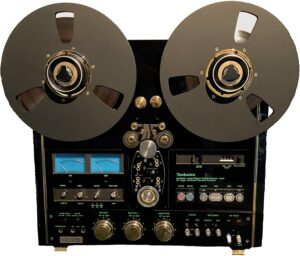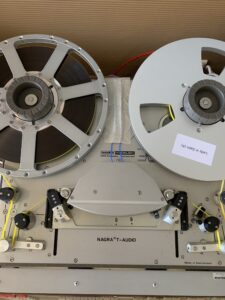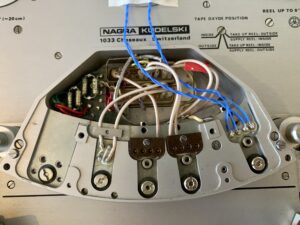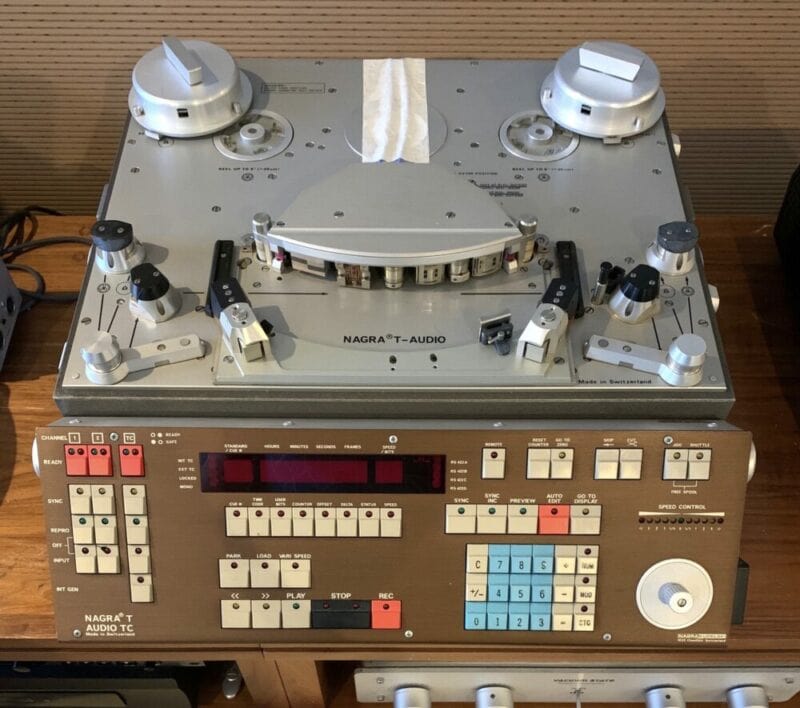In the previous article in this series (Issue 132), we discussed the rationale for listening to open reel tapes in this era of digital music. If you love certain artists and their recordings from the early stereo era until the advent of digital, which was between the mid-1950s and the late 1970s, and you have access to high-quality copies of the master tapes of these recordings, the tapes will get you closest to the original intention of the artists and recording engineers. In this article, I will discuss the issues related to playback equipment.
Open reel tape machines were at one time quite popular in the domestic setting. Early machines used tube electronics, but most machines found on the used market today are transistorized. By the mid-1970s, the market came to be dominated by Japanese brands such as Technics, Sony, Sansui, Akai, Denon and so on. Most domestic tape decks have a 4-track playback head as well as a 2-track playback head or 2-track playback/record head. Separate heads for playback and record are recommended, as the heads should be optimized for their individual functions. Some machines also have an auto-reverse function; when the playback of one side of a 4-track tape ends, the deck automatically reverses direction so that the other side is played without needing to manually flip the reels. Some open reel decks only have two speeds, usually 3.75 inches per second (ips) and 7.5 ips, whereas the more expensive machines can play at 15 ips as well.
Cheaper open reel decks usually only have one equalization standard, NAB, whereas the more expensive consumer and “prosumer” machines often have a choice of NAB and IEC1/CCIR equalizations. (Tape equalization is similar in principle to the RIAA equalization used in phono playback. EQ is used for both the recorded media and the playback device in order to minimize noise.) Most of the old commercial 4-track tapes sold in North America run at 7.5ips and have NAB equalization. If you buy a machine to play back these old commercial tapes only, a deck with a 4-track playback head that runs at 3.75 ips and 7.5 ips with NAB equalization will be sufficient. However, be aware that most of the new commercial pre-recorded tapes, such as those from Analogue Productions and The Tape Project, are 2-track, run at 15 ips and employ IEC1/CCIR equalization. They will not play on the older machines. All the consumer-grade open reel decks have 1/4 inch heads, and while most can accommodate 10.5-inch reels, some smaller decks can only accommodate 7-inch reels.
Studio machines are different beasts altogether. Their head blocks can usually be changed quickly to accommodate different track widths. Most work at 7.5ips, 15ips and 30ips, and have switchable equalizations. They can accommodate at least 10.5-inch reels and sometimes up to 12-inch reels. They are usually much larger, much heavier and much more expensive than consumer and prosumer machines.
The quality of a reel to reel tape machine depends on its speed stability, the construction of the heads and the quality of the electronics. The mechanics of tape machines are far more complex than that of turntables, and require careful calibration. The better units usually employ separate direct drive motors for the reels and capstan, with servo control to ensure speed stability. Some machines have separate capstans before and after the head block, or in the case of Technics, a loop mechanism where two pinch rollers work off the same capstan with the tape running in a loop between the rollers. The way a machine physically handles the tapes is also important for their longevity.
A few consumer machines have a separate connection to the tape heads, so that external record and playback electronics can be used. Most professional machines also have built-in playback and record electronics in the form of slot-in boards. As we will discuss later, most open reel decks can be easily modified to work with external electronics.
Which type of machine is the best choice for today’s audiophiles? If you want to play back 4-track tapes, you will need to have a consumer deck, or you will need to install an aftermarket 1/4-inch 4-track playback head in your studio machine. The availability of spare parts and maintenance also needs to be considered. Spare parts are no longer available for most of the consumer open reel decks, but there are specialists who continue to provide maintenance service and even modify certain models.
The most popular consumer machines today seem to be the Technics RS 1500 Series and the Otari MX5050. Otari continued to manufacture the MX5050 until at least 2012. The Technics and Otari models can play both 2- and 4-track tapes, have switchable equalization, and offer very respectable sound quality in stock condition. J-Corder is a specialist in the restoration, maintenance and modification of the RS-1500. United Home Audio sells several levels of modifications for Tascam tape recorders, including improved heads and electronics. They have received highly favorable reviews and are perennial crowd favorites in audio shows. Chris Mara, a recording engineer in Nashville, has a company called Mara Machines that restores MCI professional tape machines for studio clients as well as audiophiles. The prices are very reasonable, and a good entry point for audiophiles who want to explore tape playback.
 Technics RS 1500 Series.
Technics RS 1500 Series.If you have the space, a studio machine is a better option in my opinion. My first open reel tape deck was an Otari MX5050, but I soon switched to a Nagra. Since many studios continue to use them, spare parts and maintenance are widely available. Studio machines are generally built to a much higher standard than consumer models, to withstand the heavy workload of a busy studio. Most of the music available on LPs was most likely transferred using one of these machines, so you can’t go much wrong there.
Studer and Ampex are the two most common brands in Europe and the US, respectively. The first important Studer deck was the C37, which employs tube electronics. The Beatles recorded Sgt. Pepper ‘s Lonely Hearts Club Band on a J37, the 4-track, 1-inch version of the C37, which was then mixed to stereo on another C37. You can still make a recording on this setup at Abbey Road Studios today. A friend bought a C37 and painstakingly restored it to its original specifications in the space of one year. In stock form, this is the best machine I have heard so far. Due to the age of the deck, its fame and its rarity, a C37 in good condition today will fetch a very high price.
 A Studer J37 tape machine in Abbey Road Studios. Courtesy of Abbey Road Studios.
A Studer J37 tape machine in Abbey Road Studios. Courtesy of Abbey Road Studios.The successor to the C37 was the Studer A80, which is a transistor unit. Alan Parsons produced Pink Floyd’s The Dark Side of the Moon on a new A80 at Abbey Road Studios not long after it was installed. This was the most popular Studer studio machine and many were sold to recording and mastering studios as well as radio stations. They are therefore relatively easy to find, but beware of those with high mileage that will need a complete overhaul. They are very reliable, and like the Energizer Bunny, will just keep going and going. The A80 is also one of the best-sounding machines available in its stock, unmodified form.
After the Studer A80 series came the A800 Series, with the A820 being the last machine in the series. Most A820s on the market are multi-track machines, sometimes with up to 24 tracks. They are mechanically superb but expensive. Those looking for a more compact unit can consider the A807 and the A810.
Studer also sold consumer machines under the brand Revox. The Revox A77 and the more updated B77 were quite popular, but personally I would go for the A807. If I had the space and the means, I would love to have a C37 and an A820. Unfortunately, Studer is no longer producing recorders and only makes digital mixers nowadays. However, it is not difficult to find specialists who can maintain these machines.
AEG was the inventor of the Magnetophon, the first modern tape recorder. They marketed their machines under the brand Telefunken, better known to pro audio professionals and to audiophiles for their incomparable studio microphones, amplifiers and vacuum tubes. The Telefunken M10 vies with the Studer C37 and the Ampex MR70 for the title of the most desirable vacuum-tube tape recorder. The most common Telefunken models on the market are the M20 and M21, the difference being the M20 has four speed selections whereas the M21 only has two. These recorders were sold in the tens of thousands to radio stations throughout Germany, and can be bought in good working order for less than $3,000 on the used market. They are mechanically very robust workhorses, but they do not sound as good as the Studer A80. Beware – some machines are configured to play with the oxide of the tape reel on the outside, a configuration peculiar to German radio stations.
Ampex was the first company to manufacture tape recorders in North America, and these were widely sold in both the professional and consumer markets. The ATR-102 (2-track version of the ATR-100 Series) was the most successful mastering deck the company ever produced. It is also the first to feature a servo-controlled, direct-drive capstan system, which greatly diminishes wow and flutter. It is generally regarded as one of the best mastering machines, with a price to match. Both Analog Productions and The Tape Project employ the ATR-102 to copy their tapes. ATR Services still provides maintenance for this model.
Nagra was the first company to produce a portable tape recorder, which transformed location recording for the film industry and news media. The Nagra IV-S was the most popular portable recorder in its era, and was pretty much standard issue for reporters and film crews. Therefore, they can still be easily found on the used market. Although the Nagra is just about indestructible, many have seen a fair bit of abuse. The machine comes in two versions, one with a time code feature and the other with a non-pilot configuration. The time code version has a narrower track width and an additional time code head. It is therefore preferable to have the version with stereo heads, to maximize the track width. As the supply is plentiful on the used market, the cost is not high.
However, the machine can only accommodate 7-inch reels, requiring a separate adapter to play 10.5 inch reels. This QGB adapter will cost more than three times the price of the recorder itself, if you can find one to buy. There is an aftermarket adapter currently available at a much lower cost, but I cannot vouch for its functionality. The machine runs at 3.75, 7.5 and 15 ips. It has NAB, IEC1/CCIR and Nagramaster equalizations. Nagramaster is a proprietary equalization that gives a better signal to noise ratio at the expense of 3 dB lower high-frequency headroom. It also has stereo microphone amplifiers with phantom power, and an integrated monitor speaker. It can run on batteries. The machine was conceived mainly as a recorder and it makes stunning recordings. However, the playback is not meant to be of audiophile quality, but it is possible to wire the playback head out of the circuit to make use of external electronics. The Nagra IV-S has the same playback and record heads as its larger and much more expensive sibling, the Nagra TA.
The Nagra T-Audio was initially designed to be a scientific instrument. The transport has extremely low wow and flutter, and handles tapes very gently. These units were extremely expensive when new, and most of them were sold to film studios. They represent the epitome of Swiss precision engineering; if Studer were the equivalent of Rolex, then Nagra would be Patek Philippe. I measured the frequency response of a stock Nagra T-Audio with an MRL (Magnetic Reference Laboratory) calibration tape, and it was absolutely flat from 32 Hz to 20 kHz. However, the playback circuit is based on op amps and has all sorts of compensation networks for high-frequency compensation, head gap compensation and other functions. The sound is extremely dynamic, but has more than a trace of an electronic quality, making it sound rather upfront and aggressive. It sounds less three-dimensional through the stock electronics than when played through my tube tape head preamplifier, which could indicate some phase non-linearities. However, it is very easy to wire the playback head directly to an external tape head preamplifier to obtain better sound (see photos).


Nagra is still very much in business, but seems to have lost its mojo in the pro audio world. The company has placed its bet on high-end audio. Nagra is in fact a large company specializing in the security and communications sectors, with audio only contributing a small percentage of its revenue. The company has spun off its audio business into a separate entity called Audio Technology Switzerland, and they still maintain a stock of spare parts for their legacy products. In recent years, Nagra has been demonstrating their high-end electronics at audio shows with a Nagra TA as the music source. They have also started selling refurbished recorders with warranties. Given enough demand, they might even resume building new machines!
Stellavox was another high-end tape machine manufacturer in Switzerland, and had a portfolio quite similar to Nagra’s. The SP8 and SP9 were their answers to the Nagra IV-S, but sold in far smaller numbers. Their TD9 master recorder was legendary but was only produced in small numbers, due to its high price. Interestingly, the production of this recorder has recently resumed by Sepea Audio, using new parts from the original suppliers as well as from existing stock. As far as I know, this is the only classic tape recorder currently still in production. The price of 36,000 Euros is very reasonable for a top-end master recorder, and competitive with ultra-high-end vinyl-based equipment.

Lyrec of Denmark was another niche manufacturer of high-end studio recorders. The two models of interest to audiophiles are the FRED, which is a portable machine designed for tape playback and editing, and FRIDA, a compact studio mastering recorder. Both machines are of very high quality, and are relatively compact. They enjoy cult status among professional studio engineers. The company still provides servicing for these machines, but they no longer manufacture analog recorders.
In Part Three, I’ll discuss open reel tape decks that are currently being manufactured.
Header image: Adrian Wu’s Nagra T-Audio machine.



